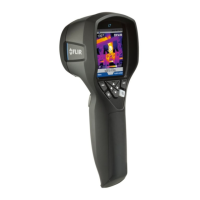range of thermal anomalies can be found in BINDT Guides to thermal imaging (Infrared
Thermography Handbook; Volume 1, Principles and Practise, Norman Walker, ISBN
0903132338, Volume 2, Applications, A. N. Nowicki, ISBN 090313232X, BINDT, 2005).
16.3.8.3.1 Requirements
A thermographic survey to demonstrate continuity of insulation, areas of thermal
bridging and compliance with Building Regulations should include the following:
■ Thermal anomalies.
■ Differentiate between real thermal anomalies, where temperature differences are
caused by deficiencies in thermal insulation, and those that occur through con-
founding factors such as localised differences in air movement, reflection and
emissivity.
■ Quantify affected areas in relation to the total insulated areas.
■ State whether the anomalies and the building thermal insulation as a whole are
acceptable.
16.3.8.4 Quantitative appraisal of thermal anomalies
A thermographic survey will show differences in apparent temperature of areas within
the field of view. To be useful, however, it must systematically detect all the apparent
defects; assess them against a predetermined set of criteria; reliably discount those
anomalies that are not real defects; evaluate those that are real defects, and report
the results to the client.
16.3.8.4.1 Selection of critical temperature parameter
The BRE information Paper IP17/01 (Information Paper IP17/01, Assessing the Effects
of Thermal Bridging at Junctions and Around Openings. Tim Ward, BRE, 2001) pro-
vides useful guidance on minimum acceptable internal surface temperatures and
appropriate values of Critical Surface Temperature Factor, f
CRsi
. The use of a surface
temperature factor allows surveys under any thermal conditions to show areas that
are at risk of condensation or mould growth under design conditions.
The actual surface temperature will depend greatly on the temperatures inside and
outside at the time of the survey, but a ‘Surface Temperature Factor’ (f
Rsi
) has been
devised that is independent of the absolute conditions. It is a ratio of temperature
drop across the building fabric to the total temperature drop between inside and
outside air.
For internal surveys: f
Rsi
= (T
si
– T
e
)/(T
i
– T
e
)
T
si
= internal surface temperature
T
i
= internal air temperature
T
e
= external air temperature
Publ. No. T559382 Rev. a358 – ENGLISH (EN) – June 23, 2009 87
16 – Introduction to building thermography

